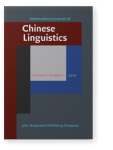Vol. 6:1 (2019) ► pp.27–45
Encoding counterfactuality in Chinese, syntactically
In this article, I demonstrate how past time-reference, modality, negation, conditional, and the causal relationship between the protasis and the apodosis work together to generate counterfactuality in Chinese, syntactically. I study two syntactic means that can help construe counterfactuality in Chinese. First, I study the case of the specialized complementizer yaobushi ‘if not for’ based on Ippolito and Su (2009) by arguing that the causal clausal relationship and the overt or covert modality are obligatory in yaobushi counterfactual; in particular, I resort to the inherent negative entailment of the modal adverb cai ‘not until’ that satisfies the exhaustive operator to account for the needed negation in cai apodosis. Second, I propose that a hypothetical conditional clause with a past time-reference guarantees past counterfactuality in Chinese. I extend the morphological past-tense exclusion operator for counterfactuality (Iatridou 2000) to a more general and more pragmatic past time-reference to include tenseless languages like Chinese. I also show the special typological status of past tense and past counterfactual.
Article outline
- 1.Introduction
- 2.There is counterfactuality reasoning in Chinese
- 3.The exclusion operator in counterfactuality
- 4.Chinese counterfactual
- 4.1Factual ambiguity in tenseless Chinese
- 4.2Specialized complementizer yaobushi ‘if not for’
- 4.2.1Non-defeasible counterfactuality in yaobushi conditional
- 4.2.2Overt or covert modality in yaobushi counterfactual
- 4.3Hypothetical conditional and past time-reference in counterfactual
- 5.Conclusion
- Notes
-
References
